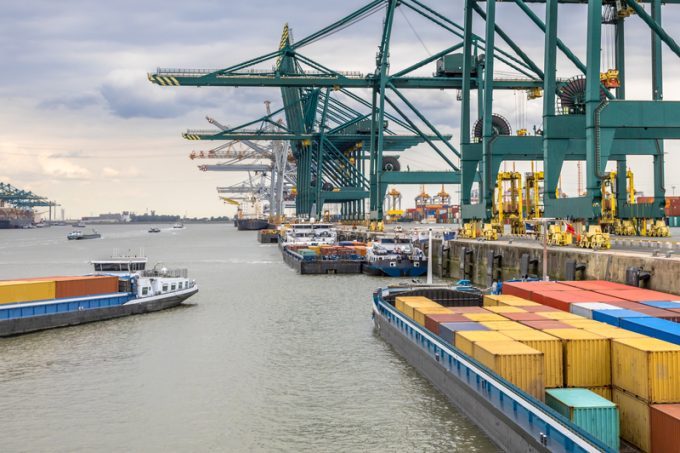Idle containership fleet dips to pandemic era lows as carriers hunt tonnage
As global demand for box ship capacity continues to dramatically outstrip supply, the number of ...
TFII: SOLID AS USUALMAERSK: WEAKENINGF: FALLING OFF A CLIFFAAPL: 'BOTTLENECK IN MAINLAND CHINA'AAPL: CHINA TRENDSDHL: GROWTH CAPEXR: ANOTHER SOLID DELIVERYMFT: HERE COMES THE FALLDSV: LOOK AT SCHENKER PERFORMANCEUPS: A WAVE OF DOWNGRADES DSV: BARGAIN BINKNX: EARNINGS OUTODFL: RISING AND FALLING AND THEN RISING
TFII: SOLID AS USUALMAERSK: WEAKENINGF: FALLING OFF A CLIFFAAPL: 'BOTTLENECK IN MAINLAND CHINA'AAPL: CHINA TRENDSDHL: GROWTH CAPEXR: ANOTHER SOLID DELIVERYMFT: HERE COMES THE FALLDSV: LOOK AT SCHENKER PERFORMANCEUPS: A WAVE OF DOWNGRADES DSV: BARGAIN BINKNX: EARNINGS OUTODFL: RISING AND FALLING AND THEN RISING

As the retail industry across Europe and North America begins to effectively shut down as governments enforce widespread social lockdown, there are increasing warnings that the container shipping industry is set to see some of the largest declines in volumes in living memory.
According to liner analyst SeaIntelligence Consulting, the possibility of a 10% decline in global container shipments – which would equate to 17m teu carried by the world’s box shipping fleet and some 80 teu handled in global container ports – has “unfortunately moved closer to reality”.
SeaIntelligence Consulting chief executive Alan Murphy said: “Economists at Goldman Sachs are now forecasting a staggering 24% decline in US GDP in the second quarter of 2020.
“We also have US business inventories being 10% larger than just before the financial crisis, when they are compared to the magnitude of sales – and during the financial crisis, inventories were reduced by 18%.
“On top of that, we are seeing restrictions in ports, a few even banning vessels if they have been in virus-afflicted countries or shutting down temporarily when they find workers who have tested positive for the virus,” he added.
The year’s first decline in container volumes was expected – the Chinese New Year holiday is an annual slump in container shipping’s diary, but as coronavirus infections grew in Wuhan, the Chinese authorities extended the two-week factory shutdown until it could bring the outbreak under control.
Hopes that this might lead to sudden surge in purchase orders being sent to Chinese producers were short-lived, however, as infection numbers grew in Europe and the subsequent hit on demand has become more obvious.
Mr Murphy also warned that the sudden precipitous drop in oil prices, which, on the face of it a welcome respite for the sector, could undermine the industry’s long-term quest for balance between supply and demand.
The problem is that the decline in oil prices has led to the differential between high-sulphur fuel oil (HFSO) and low-sulphur fuel oil (LSFO) reducing sharply. At the beginning of the year, as the IMO’s new low-sulphur regulations came into force, the difference was $300 a ton, today the difference is just $60.
This has meant the economics of investing in exhaust gas cleaning scrubbers have, effectively, been thrown out of the window and may lead numerous carriers cancelling scrubber retrofit orders, which in turn could mean more vessels on the water looking for cargo and, ultimately, a sharp decline in freight rates.
Mr Murphy added: “At the same time, scrubber installations are seriously delayed in China due to the virus. The consequence might well be that vessels which were otherwise planned to go for scrubber installation instead re-enter the operational fleet.
“This would add more capacity to a situation where demand is about to drop sharply.”
Comment on this article
Andreas Koût
March 23, 2020 at 3:30 pmHello.
These forecasts for global ocean volumes in 2020 are still to high for me and my team,we are envisaging a drop of 30 to 40% of 80 Mio Teu´s to 48 -56 Mio Teu´s.
Well, why
redundancies in most western economies will heavily challenge the confidence in
consuming and buying of
cars,electronic articles, high-tech etc.
+
Production lines in various industry verticals have to be rebuilded from almost a zero.
This will take and need time so being very positive in terms of avilable oceanfreight volumes (but not on airfreight) we will not see the 2019 figures
prior than 2.half of 2021.
best
A.Kout
Team Akclimited
Team Akclimited
consumers conifdence has to be rebuilded and consumers have to spend money
redundanices on a global scale will have